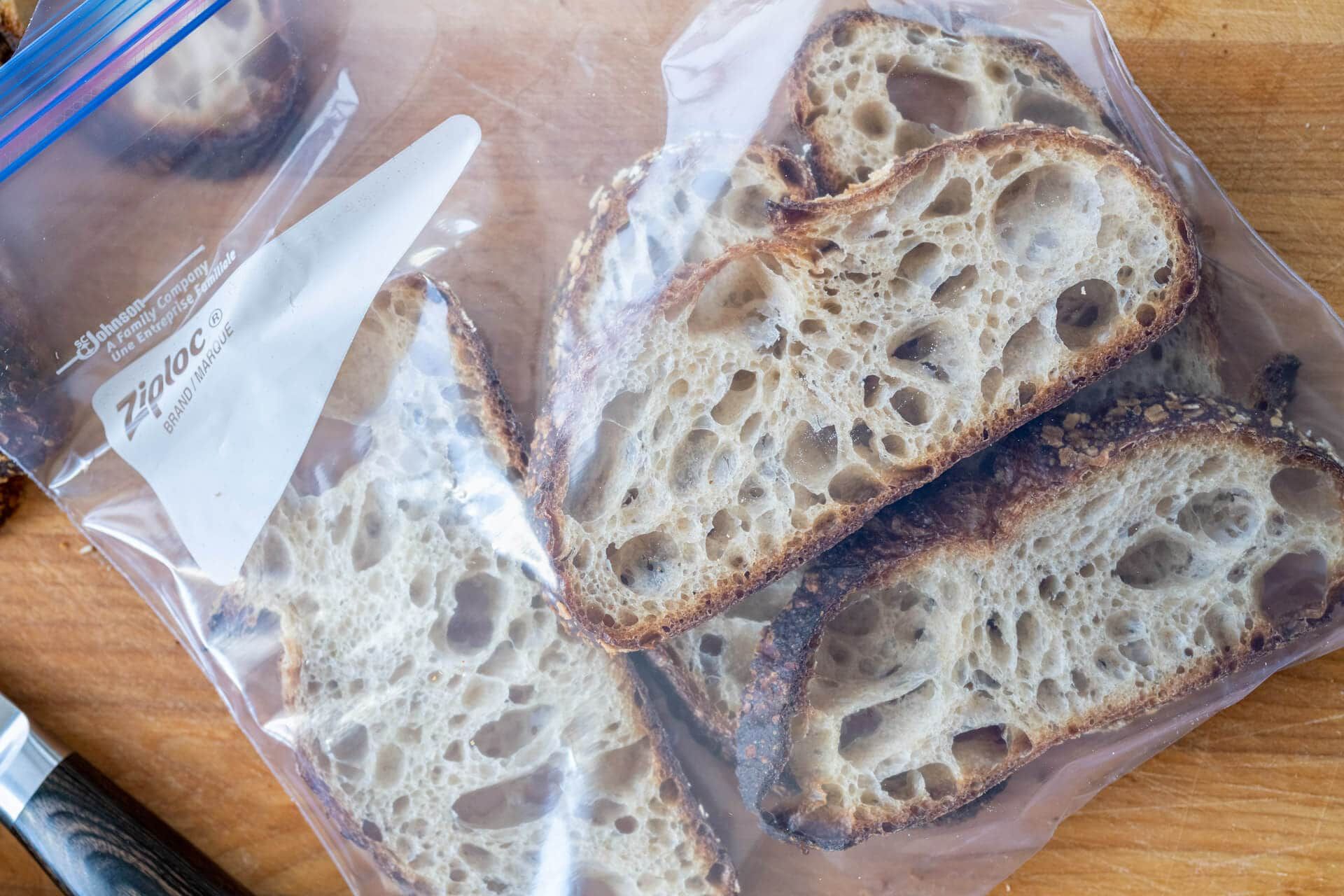

Articles
How To Store A Baguette
Modified: January 5, 2024
Learn the most effective ways to store a baguette with our informative articles. Keep your bread fresh and delicious for longer periods.
(Many of the links in this article redirect to a specific reviewed product. Your purchase of these products through affiliate links helps to generate commission for Storables.com, at no extra cost. Learn more)
Introduction – Why Properly Storing a Baguette is Important
Baguettes, with their crusty exterior and fluffy interior, are a staple in French cuisine. Whether you’ve picked up a fresh baguette from the bakery or baked one at home, knowing how to store it properly is crucial to maintaining its freshness and flavor. A properly stored baguette will stay soft and delicious for longer, giving you the opportunity to enjoy it over multiple meals or snacks.
There are several reasons why properly storing a baguette is important:
- Prolong Freshness: Baguettes are best enjoyed when they are fresh and still warm. By storing them properly, you can extend their shelf life and savor their taste for longer.
- Preserve Texture: A properly stored baguette will retain its crispy crust and soft crumb. Nobody wants a stale or soggy baguette, and proper storage techniques will help you avoid that disappointment.
- Prevent Waste: Baguettes can go stale quickly if not stored correctly. By knowing how to store them properly, you can avoid unnecessary waste and make the most out of your delicious bread.
- Save Money: If you frequently buy baguettes, learning the proper storage techniques can help you save money by allowing you to enjoy the bread for more than just one meal. You won’t have to worry about the baguette going stale before you have a chance to finish it.
In the next sections, we will explore the different factors to consider when storing a baguette and discuss various methods you can use to keep your baguette fresh and tasty for as long as possible.
Key Takeaways:
- Properly storing a baguette is crucial for maintaining its freshness, flavor, and texture. Consider factors like temperature, humidity, and handling to enjoy delicious baguettes over multiple meals.
- Whether you wrap it in paper, use a bread box, or store it in a pantry, proper storage techniques can help you savor the delightful taste and texture of a baguette for longer. Handle with care, check for freshness, and revive stale baguettes to reduce waste and enjoy every bite.
Read more: How To Store French Baguette
Factors to Consider – Temperature and Humidity – Handling and Transportation
When it comes to storing a baguette, there are a few important factors to take into consideration to ensure its freshness and longevity. Two key factors to consider are the temperature and humidity levels in your storage environment, as well as proper handling and transportation techniques.
Temperature and Humidity:
The ideal temperature for storing a baguette is around room temperature, between 68-72°F (20-22°C). Extreme temperatures, such as direct sunlight or a very cold refrigerator, can cause the baguette to stale or dry out quickly. Additionally, humidity plays a crucial role in maintaining the texture of the bread. Too much humidity can make the crust soft and chewy, while too little can make it hard and dry. Aim for a moderate level of humidity, around 60-70%, to keep the baguette in optimal condition.
Handling and Transportation:
Proper handling and transportation of a baguette are imperative to maintain its integrity. When purchasing a baguette from a bakery, make sure to handle it with care to avoid squishing or damaging the delicate crust. If you’re transporting the baguette, use a baguette bag or wrap it in a cloth or paper to protect it from moisture loss and to maintain its shape and crispiness. Avoid placing heavy items on top of the baguette, as this can cause it to flatten or become misshapen.
By carefully considering the temperature and humidity levels in your storage environment and implementing proper handling and transportation techniques, you can significantly prolong the freshness and quality of your baguette. In the next section, we will explore various methods for storing a baguette at home.
Choosing the Right Storage Method – Wrapping in Paper or Cloth – Using a Bread Box or Bread Bag – Storing in a Bread Drawer or Pantry
When it comes to storing a baguette, there are several methods you can choose from. The right storage method will depend on your preference and the available resources in your kitchen. Let’s explore three common storage methods: wrapping in paper or cloth, using a bread box or bread bag, and storing in a bread drawer or pantry.
Wrapping in Paper or Cloth:
One popular method for storing a baguette is wrapping it in paper or cloth. To wrap a baguette using this method, start by ensuring the bread is at room temperature. Gently place the baguette in a clean, dry kitchen towel or parchment paper. Fold the edges of the cloth or paper over the baguette, creating a snug yet breathable wrap. Secure the ends with tape or a rubber band, if necessary. This method helps to retain moisture while allowing the bread to breathe, keeping the crust crispy and the crumb soft.
Using a Bread Box or Bread Bag:
An alternative method for storing a baguette is by using a bread box or a bread bag. Bread boxes are designed to provide a controlled storage environment for bread, with ventilation holes to regulate humidity levels. Simply place the baguette inside the bread box and close the lid. If you don’t have a bread box, you can also use a bread bag specifically designed to keep bread fresh. Place the baguette inside the bag, twist the top to seal it, and ensure it is tightly closed.
Storing in a Bread Drawer or Pantry:
If you have a dedicated bread drawer or a pantry with controlled temperature and humidity levels, you can store a baguette there. Make sure the drawer or pantry is clean and dry before placing the baguette inside. If the baguette came in a paper or plastic bag from the bakery, you can store it as is. However, if the bread is unwrapped, consider placing it in a cloth or paper bag to protect it from drying out.
Ultimately, the choice of storage method will depend on your personal preference and the available storage options in your kitchen. Each method has its own benefits and drawbacks, so feel free to experiment and find the one that works best for you. In the next section, we will provide step-by-step instructions for each storage method.
Storing a Baguette in Paper or Cloth – Step-by-Step Instructions – Benefits and Drawbacks of This Method
Storing a baguette in paper or cloth is a popular method that helps maintain the bread’s freshness while preserving its crustiness. Here are the step-by-step instructions for this storage method, along with its benefits and drawbacks:
Step 1: Ensure Room Temperature
Before wrapping the baguette, make sure it is at room temperature. This will help maintain the quality and texture of the bread.
Step 2: Use a Clean, Dry Cloth or Parchment Paper
Place a clean kitchen towel or parchment paper on a flat surface. Ensure it is dry to prevent any moisture transfer to the bread.
Step 3: Position the Baguette in the Center
Gently position the baguette in the center of the cloth or paper, aligning it horizontally. Make sure the bread is not squished or bent.
Step 4: Fold Over the Edges
Fold the edges of the cloth or paper over the baguette, encompassing it completely. Keep the wrap snug but not too tight, allowing some breathing room for the bread.
Step 5: Secure the Ends
If necessary, secure the ends of the cloth or paper with tape or a rubber band to keep the wrap in place.
Benefits of Storing a Baguette in Paper or Cloth:
- Retains Moisture: This method helps keep the baguette moist, ensuring a soft and fresh crumb.
- Promotes Crispy Crust: Wrapping the baguette in paper or cloth helps maintain the crust’s crispiness by preventing moisture loss.
- Breathability: The wrap allows the bread to breathe, preventing condensation and avoiding a soggy crust.
- Easy and Accessible: This method requires minimal resources and can be easily done at home with everyday items.
Drawbacks of Storing a Baguette in Paper or Cloth:
- Limited Shelf Life: While this method helps extend the freshness of the baguette, it still has a limited shelf life compared to some other storage methods.
- Risk of Absorbing Odors: If the cloth or paper used for wrapping absorbs strong odors, it can transfer those odors to the bread.
- Possible Moisture Transfer: In high humidity environments, there is a slight risk of moisture transferring from the cloth or paper to the bread, potentially compromising its texture.
Storing a baguette in paper or cloth is a practical and effective method to preserve its freshness. The benefits of retaining moisture and promoting a crispy crust outweigh the drawbacks if properly executed. In the next section, we will explore another popular storage method: using a bread box or bread bag.
Store a baguette at room temperature for up to 2 days in a paper bag to maintain its crust. To keep it fresh longer, freeze it in a resealable plastic bag for up to 3 months.
Using a Bread Box or Bread Bag – Step-by-Step Instructions – Benefits and Drawbacks of This Method
Using a bread box or bread bag is an excellent method for storing a baguette while maintaining its freshness. This method provides a controlled environment to keep the bread at its best. Here are the step-by-step instructions for using a bread box or bread bag, along with its benefits and drawbacks:
Step 1: Clean and Prepare the Bread Box or Bread Bag
Ensure that the bread box or bread bag is clean and dry. Cleaning it beforehand prevents any unwanted contamination or moisture transfer to the bread.
Step 2: Place the Baguette Inside
Gently place the baguette inside the bread box or bread bag, ensuring it fits comfortably. The box or bag should be spacious enough to accommodate the size of the bread.
Step 3: Close the Lid or Seal the Bag
If using a bread box, close the lid securely to create a controlled environment. For a bread bag, twist the top and seal it tightly to prevent air exposure.
Benefits of Using a Bread Box or Bread Bag:
- Preserves Freshness: A bread box or bread bag provides an enclosed space that helps retain the bread’s moisture, allowing it to stay fresher for longer.
- Controls Humidity Levels: These storage options regulate the humidity inside, preventing the baguette from drying out or becoming soggy.
- Protects from Contaminants: The enclosed container or bag helps shield the bread from outside contaminants, such as dust or insects.
- Convenient and Space-Saving: Bread boxes and bread bags are specifically designed for bread storage, making them convenient and efficient. They also take up minimal space on your kitchen countertop or in your pantry.
Drawbacks of Using a Bread Box or Bread Bag:
- Limited Capacity: Depending on the size, a bread box or bread bag may have a limited capacity, which means it may not be suitable for storing multiple baguettes or large loaves of bread.
- May Require Additional Cleaning: Over time, bread crumbs and debris may accumulate in the bread box, requiring periodic cleaning to keep it hygienic.
- Not Ideal for Crusty Crusts: If you prefer a soft crust, this method is perfect. However, if you enjoy a very crispy crust, using a bread box or bag may soften it slightly.
Using a bread box or bread bag is a convenient and effective way to store a baguette, providing a controlled environment that helps preserve its freshness. The benefits of prolonged freshness and controlled humidity make this method a popular choice for bread storage. In the next section, we will discuss another storage option: storing a baguette in a bread drawer or pantry.
Read more: How To Store Baguette Bread
Storing a Baguette in a Bread Drawer or Pantry – Step-by-Step Instructions – Benefits and Drawbacks of This Method
Storing a baguette in a bread drawer or pantry can be a convenient option, especially if you have a dedicated space for bread storage. Here are the step-by-step instructions for storing a baguette in a bread drawer or pantry, along with its benefits and drawbacks:
Step 1: Prepare the Bread Drawer or Pantry
Ensure that the bread drawer or pantry is clean, dry, and free from any potential contaminants. Give it a quick wipe-down if needed.
Step 2: Place the Baguette in the Storage Space
Gently place the baguette in the bread drawer or pantry, ensuring it is not crushed or bent. Position it in a way that doesn’t crowd or compress the bread.
Step 3: Consider Using a Bag or Cover (Optional)
If the baguette is unwrapped or came in a paper or plastic bag from the bakery, you can choose to keep it as is or place it inside a cloth or paper bag for added protection.
Benefits of Storing a Baguette in a Bread Drawer or Pantry:
- Convenient and Accessible: Storing a baguette in a bread drawer or pantry allows for easy access to fresh bread whenever you need it.
- Adequate Storage Space: If you have a designated bread storage area, such as a bread drawer or pantry, it can accommodate several baguettes or other types of bread.
- Preserves Freshness: With a controlled environment, the bread drawer or pantry helps maintain the baguette’s freshness and texture for longer.
- Protects from External Factors: By keeping the baguette in a closed storage space, it is shielded from potential contaminants, such as dust or insects.
Drawbacks of Storing a Baguette in a Bread Drawer or Pantry:
- Potential Dryness: Depending on the conditions inside your bread drawer or pantry, the bread might dry out more quickly compared to other storage methods.
- Possible Flavor Absorption: If the bread is stored together with strongly scented foods in the pantry, it may absorb those flavors, impacting its taste.
- Requires Adequate Space: A dedicated bread drawer or enough pantry space is needed to store the baguette properly. If space is limited, this method may not be feasible.
Storing a baguette in a bread drawer or pantry can be a practical choice, especially if you have a designated storage space. The convenience, accessibility, and decent storage capacity make it an appealing option. However, be mindful of the potential for drying out and flavor absorption. In the next section, we will provide tips for maintaining the freshness of your baguette.
Tips for Maintaining Freshness – Proper Handling Techniques – Checking for Freshness – Reviving a Stale Baguette
To ensure your baguette stays fresh and enjoyable for as long as possible, there are a few key tips and techniques to keep in mind. By following these practices, you can maximize the shelf life and maintain the quality of your baguette. Here are some tips for maintaining the freshness of your baguette:
Proper Handling Techniques:
- Do not squeeze or squeeze the baguette: Handle the baguette with care to prevent squishing or damaging the delicate crust. A gentle touch will help maintain its shape.
- Keep the baguette away from moisture: Moisture can quickly make the crust soggy and the bread stale. Ensure that the baguette is stored in a dry environment to preserve its texture.
- Avoid exposing the baguette to extreme temperatures: Extreme heat or cold can affect the freshness of the baguette. Keep it away from direct sunlight or refrigeration, as this can make it stale or dry.
Checking for Freshness:
- Check the crust: The crust of a fresh baguette should have a golden brown color and a crispy texture. Avoid baguettes with overly pale or hardened crusts.
- Press the baguette: Gently press the baguette with your fingers. A fresh baguette will spring back slightly when pressed, while a stale one will remain indented.
- Listen for the sound: Give the baguette a gentle tap or squeeze the end. A correctly stored baguette will have a hollow sound, indicating that it is still fresh.
Reviving a Stale Baguette:
- Sprinkle water and reheat: If your baguette has gone slightly stale, you can sprinkle some water on the crust and heat it in the oven for a few minutes. This can help rejuvenate the crust and make the bread slightly softer.
- Make breadcrumbs or croutons: If the baguette has become too stale to enjoy as is, you can still repurpose it! Process it into breadcrumbs for later use or cut it into cubes to make homemade croutons.
- Toast or make sandwiches: Toasting a stale baguette can revive its flavor and crisp up the crust. You can also use it to make delicious sandwiches or bruschetta.
By following proper handling techniques, regularly checking for freshness, and knowing how to revive a stale baguette, you can make the most out of your bread and avoid unnecessary waste. Enjoy your baguette while it’s fresh, and transform it into exciting dishes even when it becomes slightly stale.
As we conclude our article, remember that proper storage techniques and handling play a crucial role in maintaining the quality of your baguette. Whether you choose to wrap it in paper or cloth, use a bread box or bread bag, or store it in a bread drawer or pantry, adapting these tips and techniques will help you enjoy a delicious baguette every time you take a bite.
Conclusion
Properly storing a baguette is essential to preserve its freshness, flavor, and texture. By considering factors such as temperature, humidity, handling, and transportation, you can ensure that your baguette stays delicious and enjoyable for longer periods of time.
We discussed various storage methods, including wrapping in paper or cloth, using a bread box or bread bag, and storing in a bread drawer or pantry. Each method has its own benefits and drawbacks, so it’s important to choose the one that suits your preferences and available resources.
When storing a baguette in paper or cloth, you can retain moisture and maintain a crispy crust. Using a bread box or bread bag provides a controlled environment that helps preserve freshness and control humidity levels. Storing a baguette in a bread drawer or pantry offers convenience and accessibility, although you should be mindful of potential dryness and flavor absorption.
In addition to storing techniques, we provided tips for maintaining freshness, such as proper handling techniques and checking for freshness. We highlighted the importance of handling baguettes with care, keeping them away from moisture and extreme temperatures, and checking for signs of freshness through the crust, texture, and sound. We also explored ways to revive a stale baguette through sprinkling water and reheating, repurposing as breadcrumbs or croutons, or toasting and using it for sandwiches.
Remember, the key to maintaining the freshness of your baguette is to handle it properly, store it in suitable conditions, and check for signs of freshness. By following these guidelines, you can enjoy the delightful taste and texture of a baguette over multiple meals or snacks, and reduce unnecessary waste.
So next time you bring home a baguette from the bakery or bake one yourself, use these methods and tips to ensure that your baguette remains soft, crusty, and delicious. Share the joy of fresh bread with loved ones and savor the delightful flavors that a well-preserved baguette has to offer.
Happy baguette storage and happy eating!
Frequently Asked Questions about How To Store A Baguette
Was this page helpful?
At Storables.com, we guarantee accurate and reliable information. Our content, validated by Expert Board Contributors, is crafted following stringent Editorial Policies. We're committed to providing you with well-researched, expert-backed insights for all your informational needs.















0 thoughts on “How To Store A Baguette”